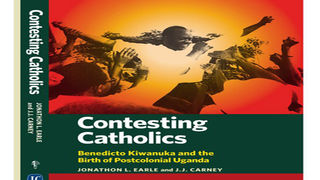
Reviews & Profiles
Prime
Book review: Making sense of religion in Uganda’s body politic
What you need to know:
Topic
The authors of the book move to address oversimplifications that DP was “simply a sectarian ‘Catholic Party’ … that sought to upend political Protestantism in the Kingdom of Buganda.” To this end, Kiwanuka—whose “religious convictions and conception of liberal democracy emerged out of his identification with each of Uganda’s three Catholic missions”—is materialised as the book’s central figure.
A force of nature in the strictest sense, Benedicto Kiwanuka’s determination to ensure that a self-ruling Uganda doesn’t shoot itself in the foot is startling in its significance and candour. Contesting Catholics: Benedicto Kiwanuka and the birth of postcolonial Uganda goes to punishing lengths to show how Uganda’s first prime minister was never a passive observer of his own fate.
The book deploys a trove of Kiwanuka’s never-before-seen private papers to offer an enticing conceit. It leans into scholarly analysis and cerebral deep dives to project Kiwanuka as a tour de force of uncut activism. A handwritten note that is undated captures his readiness to stride boldly into political minefields.
“But as for myself, I am going to leave my protection to God. If it pleases Him for me to die, let it be,” Kiwanuka wrote, adding, “I shall do my work at His place. The only question is to be prepared at all times.”
Kiwanuka eventually did die after a so-called prolonged execution in September 1972, that was reportedly sanctioned by the man who named him Chief Justice—Idi Amin. The book mentions this high-profile death for a fleeting moment as this is anything but its central plank. If its purpose and significance cannot be reduced to a single catchphrase or macabre death for that matter, the reverse is true for the combustible mix of Catholicism and Ganda sub-imperialism.
While Kiwanuka had national aspirations, the Democratic Party (DP) that he shaped into “a viable nationalist alternative to Uganda Peoples Congress (UPC) in the late 1950s and early 1960s” was—much like him—“constrained by the regional politics of the era.” This came after “Ganda courtiers and chiefs” allied to Protestantism emerged victorious following the religious civil wars that occupied the late 1880s and early 1890s.
The authors of the book gently pull apart the prejudices that bedevilled the spread of religions in Buganda. Readers’ attention is drawn to Kabaka Muteesa I, having under “70 Muslims killed over circumcision rites, with an additional 1,000 persecuted or forced into exile.”
Between 1885 and 1887, the tables turned with Kabaka Mwanga’s maximalist approach, resulting in the purge of Christian converts. With the military backing of the Imperial British East Africa Company (IBEAC), Protestant Ganda chiefs laid claim to the capital. This outcome saw the light of day after “Mwanga was … removed from power by a broad-based Christian coalition, whose respective Protestant and Catholic factions violently turned on each other after the coup.”
The unmistakability of which faction held the upper hand was underlined by the fact that the Native Anglican Church formed a ‘sheath’ around Daudi Chwa II who—aged just one—assumed the kabakaship. The marriage of convenience that Kabaka Yekka entered into with UPC at the dawn of Independence, therefore, traces its roots to this troubled past between Protestantism and Catholicism in Buganda.
The authors of the book move to address oversimplifications that DP was “simply a sectarian ‘Catholic Party’ … that sought to upend political Protestantism in the Kingdom of Buganda.” They make clear the fact that “Catholic politics … constituted a dynamic moral economy of competing regional historiographies and disputations.”
To this end, Kiwanuka—whose “religious convictions and conception of liberal democracy emerged out of his identification with each of Uganda’s three Catholic missions”—is materialised as the book’s central figure. We see how his sensibilities—couched in Ganda sub-imperialism—end up being repulsive in a predominantly Catholic enclave such as Tesoland. Catholics in the area are “compelled … to strategise their interests through UPC” with Cuthbert Obwangor and Milton Obote working together in partnership.
An ‘enemy within’ theme is also explored, with the impact of “Catholic alternatives in the 1950s” such as Semakula Mulumba and Aloysius Darlington Lubowa deemed—to a certain degree—toxic. Lubowa, the authors, for instance, proffer, “ensured Buganda’s Catholic chiefs and parishioners resisted Kiwanuka and DP.” They proceed to add that “Lubowa’s campaign compelled the vast majority of Catholics in Buganda to join or support Kabaka Yekka.”
We also obtain an understanding of Kiwanuka’s political calculus, specifically around the ‘Lost Counties’ brouhaha. We, for instance, learn that “Kiwanuka hoped that by supporting the return of Mubende to Bunyoro, he would both unify Catholics and bolster DP’s vision for national unification.”
When Obote beat him to the role of ‘conceiving the nation’, Kiwanuka dedicated himself to calling the second president of Uganda to order. A confidential note titled “Socialism and One-Party Rule” shows the extraordinary lengths Kiwanuka was prepared to go.
“If Dr Obote intends to use force to achieve his object, then I tell him that we will resist. I offer today my body and blood, and there are a lot more who will follow my example,” Kiwanuka wrote after Obote endorsed a one-party political system on January 7, 1964. “This is our country and here we must remain and die. We have freedom and we will die free men rather than remain alive slaves. A one-party system turns the whole mass of people into slaves of the big dictator—and we will never accept it.”
Book title
Contesting Catholics: Benedicto Kiwanuka and the birth of postcolonial Uganda
Authors
Jonathon L. Earle and JJ Carney
Pages
242
Price
Shs25,000
Where to find it
Most Ugandan bookshops




